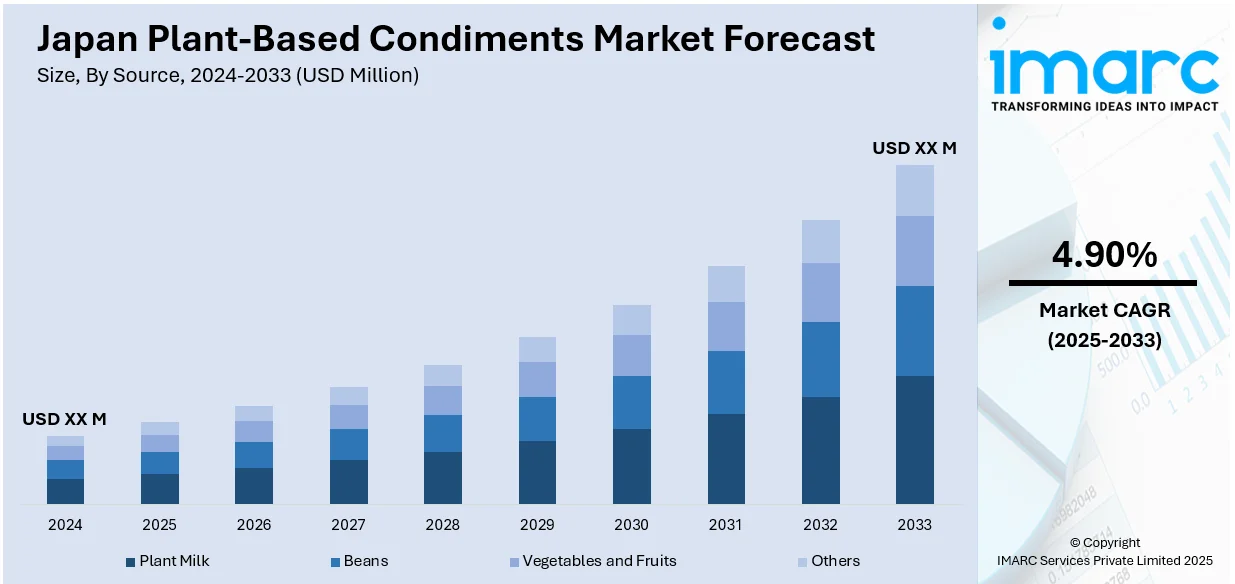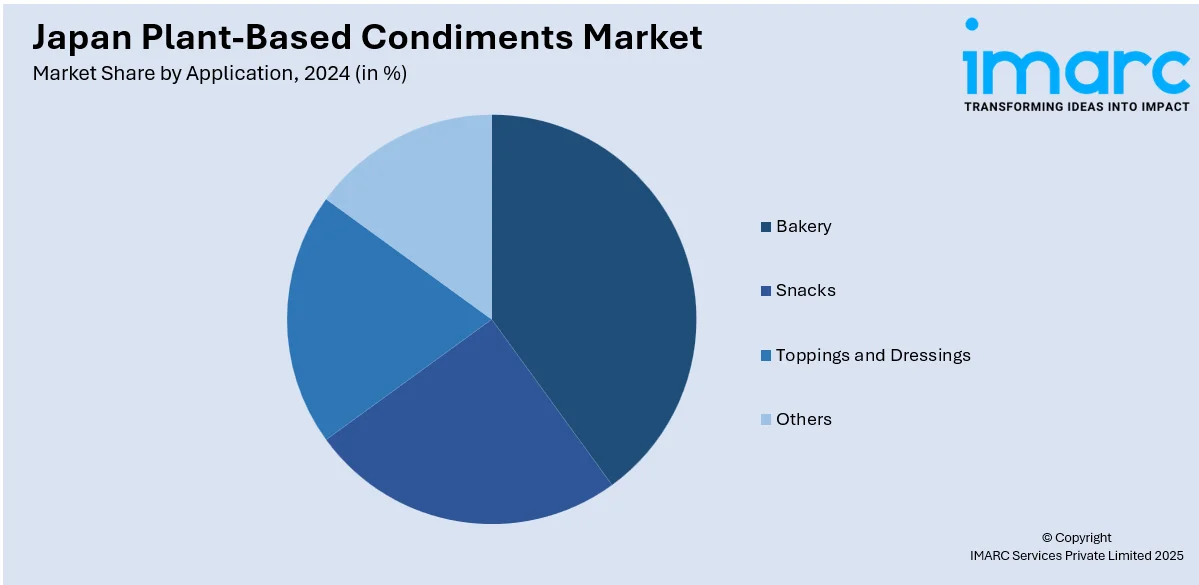
Japan Plant-Based Condiments Market Size, Share, Trends and Forecast by Source, Product, Application, End-User, and Region, 2025-2033
Japan Plant-Based Condiments Market Overview:
The Japan plant-based condiments market size is projected to exhibit a growth rate (CAGR) of 4.90% during 2025-2033. The growing adoption of plant-based lifestyles in Japan is driving the market for plant-based condiments, as consumers seek alternatives aligned with health, ethical, and environmental values. Government policies supporting sustainability, research, and innovation in plant-based foods are further supporting the market growth. These factors are prompting companies to develop diverse, flavorful condiments, contributing to the increase in the Japan plant-based condiments market share.
|
Report Attribute
|
Key Statistics
|
|---|---|
|
Base Year
|
2024
|
|
Forecast Years
|
2025-2033
|
|
Historical Years
|
2019-2024
|
| Market Growth Rate 2025-2033 | 4.90% |
Japan Plant-Based Condiments Market Trends:
Supportive Government Policies and Regulations
In recent years, Japan has emphasized sustainability and minimizing the environmental effects of food production. The governing authority is backing the growth of plant-based food choices via different initiatives, including funding for research, tax breaks, and programs aimed at encouraging sustainable farming. These efforts not only promote local creativity in plant-based food but also establish a supportive regulatory setting for companies within this industry. A significant example of this support is the $27.7 million funding awarded to alternative protein companies Umami United and IntegriCulture in 2024, intended to encourage advancements in plant-based and lab-cultured food products. This funding enables businesses to enhance their technologies and broaden their product lines. This government assistance enables plant-based condiment brands to enter the market more easily and establish a strong foundation for expansion. It also motivates businesses to develop and invest in the advancement of sustainable and eco-friendly food options, creating a favorable market environment for plant-based products in Japan. These efforts not only aid in decreasing the ecological footprint of the country but also correspond with worldwide shift toward more sustainable food production, establishing Japan as a frontrunner in the plant-based food sector.

To get more information on this market, Request Sample
Rising Popularity of Plant-Based Lifestyles
As a growing number of individuals adopt plant-based diets for ethical, health, and ecological motivations, there is a noticeable shift toward plant-based food products, including condiments. Consumers, motivated by concerns over animal welfare and the desire to reduce their ecological footprint, are increasingly choosing plant-based options that align with their values. This shift is reflected in the broader growth of the plant-based market in Japan, with the vegan food market size reaching USD 1.2 billion in 2024. Looking ahead, the market is expected to grow to USD 2.7 billion by 2033, with a compound annual growth rate (CAGR) of 9.7% from 2025 to 2033, according to IMARC Group. This rising demand for plant-based products is encouraging food manufacturers to innovate, creating a diverse array of plant-based condiments that cater to this growing segment of health-conscious, environmentally aware individuals. As the market expands, people are looking for flavorful alternatives that correspond with their dietary choices, further driving the need for plant-based condiments. This shift in consumer behavior is supporting the Japan plant-based condiments market growth, as companies continue to develop new and exciting condiments to meet the evolving tastes of individuals.
Japan Plant-Based Condiments Market Segmentation:
IMARC Group provides an analysis of the key trends in each segment of the market, along with forecasts at the country and regional levels for 2025-2033. Our report has categorized the market based on source, product, application, and end-user.
Source Insights:
- Plant Milk
- Beans
- Vegetables and Fruits
- Others
The report has provided a detailed breakup and analysis of the market based on the source. This includes plant milk, beans, vegetables and fruits, and others.
Product Insights:
- Table Dressings
- Paste, Purees, and Sauce
- Seasoning
- Pickled
A detailed breakup and analysis of the market based on the product have also been provided in the report. This includes table dressings, paste, purees, and sauce, seasoning, and pickled.
Application Insights:

- Bakery
- Snacks
- Toppings and Dressings
- Others
The report has provided a detailed breakup and analysis of the market based on the application. This includes bakery, snacks, toppings and dressings, and others.
End-User Insights:
- HoReCa
- Household and Retail
A detailed breakup and analysis of the market based on the end-user have also been provided in the report. This includes HoReCa and household and retail.
Regional Insights:
- Kanto Region
- Kansai/Kinki Region
- Central/ Chubu Region
- Kyushu-Okinawa Region
- Tohoku Region
- Chugoku Region
- Hokkaido Region
- Shikoku Region
The report has also provided a comprehensive analysis of all the major regional markets, which include Kanto Region, Kansai/Kinki Region, Central/ Chubu Region, Kyushu-Okinawa Region, Tohoku Region, Chugoku Region, Hokkaido Region, and Shikoku Region.
Competitive Landscape:
The market research report has also provided a comprehensive analysis of the competitive landscape. Competitive analysis such as market structure, key player positioning, top winning strategies, competitive dashboard, and company evaluation quadrant has been covered in the report. Also, detailed profiles of all major companies have been provided.
Japan Plant-Based Condiments Market News:
- In January 2024, The Asahi Shimbun reported that Yamaki Co., a historic tofu maker in Saitama, launched "Tofu no Mayo," a vegan, egg-free tofu-based mayonnaise. Originally created to reduce food waste, it contained half the calories and fat of regular mayo.
Japan Plant-Based Condiments Market Report Coverage:
| Report Features | Details |
|---|---|
| Base Year of the Analysis | 2024 |
| Historical Period | 2019-2024 |
| Forecast Period | 2025-2033 |
| Units | Million USD |
| Scope of the Report |
Exploration of Historical Trends and Market Outlook, Industry Catalysts and Challenges, Segment-Wise Historical and Future Market Assessment:
|
| Sources Covered | Plant Milk, Beans, Vegetables and Fruits, Others |
| Products Covered | Table Dressings, Paste, Purees, and Sauce, Seasoning, Pickled |
| Applications Covered | Bakery, Snacks, Toppings and Dressings, Others |
| End-Users Covered | HoReCa, Household and Retail |
| Regions Covered | Kanto Region, Kansai/Kinki Region, Central/ Chubu Region, Kyushu-Okinawa Region, Tohoku Region, Chugoku Region, Hokkaido Region, Shikoku Region |
| Customization Scope | 10% Free Customization |
| Post-Sale Analyst Support | 10-12 Weeks |
| Delivery Format | PDF and Excel through Email (We can also provide the editable version of the report in PPT/Word format on special request) |
Key Questions Answered in This Report:
- How has the Japan plant-based condiments market performed so far and how will it perform in the coming years?
- What is the breakup of the Japan plant-based condiments market on the basis of source?
- What is the breakup of the Japan plant-based condiments market on the basis of product?
- What is the breakup of the Japan plant-based condiments market on the basis of application?
- What is the breakup of the Japan plant-based condiments market on the basis of end-user?
- What is the breakup of the Japan plant-based condiments market on the basis of region?
- What are the various stages in the value chain of the Japan plant-based condiments market?
- What are the key driving factors and challenges in the Japan plant-based condiments market?
- What is the structure of the Japan plant-based condiments market and who are the key players?
- What is the degree of competition in the Japan plant-based condiments market?
Key Benefits for Stakeholders:
- IMARC’s industry report offers a comprehensive quantitative analysis of various market segments, historical and current market trends, market forecasts, and dynamics of the Japan plant-based condiments market from 2019-2033.
- The research report provides the latest information on the market drivers, challenges, and opportunities in the Japan plant-based condiments market.
- Porter's five forces analysis assist stakeholders in assessing the impact of new entrants, competitive rivalry, supplier power, buyer power, and the threat of substitution. It helps stakeholders to analyze the level of competition within the Japan plant-based condiments industry and its attractiveness.
- Competitive landscape allows stakeholders to understand their competitive environment and provides an insight into the current positions of key players in the market.
Need more help?
- Speak to our experienced analysts for insights on the current market scenarios.
- Include additional segments and countries to customize the report as per your requirement.
- Gain an unparalleled competitive advantage in your domain by understanding how to utilize the report and positively impacting your operations and revenue.
- For further assistance, please connect with our analysts.
 Request Customization
Request Customization
 Speak to an Analyst
Speak to an Analyst
 Request Brochure
Request Brochure
 Inquire Before Buying
Inquire Before Buying




.webp)




.webp)












